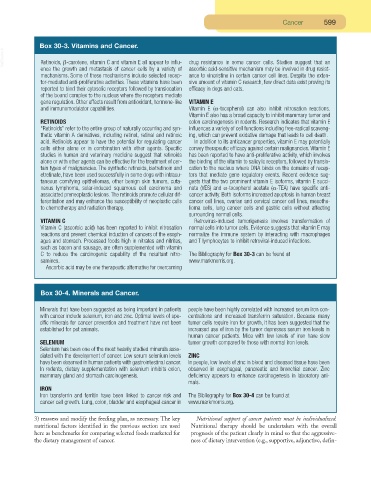Page 578 - Small Animal Clinical Nutrition 5th Edition
P. 578
Cancer 599
Box 30-3. Vitamins and Cancer.
VetBooks.ir Retinoids, β-carotene, vitamin C and vitamin E all appear to influ- drug resistance in some cancer cells. Studies suggest that an
ence the growth and metastasis of cancer cells by a variety of ascorbic acid-sensitive mechanism may be involved in drug resist-
mechanisms. Some of these mechanisms include selected recep- ance to vincristine in certain cancer cell lines. Despite the exten-
tor-mediated anti-proliferative activities. These vitamins have been sive amount of vitamin C research, few direct data exist proving its
reported to bind their cytosolic receptors followed by translocation efficacy in dogs and cats.
of the bound complex to the nucleus where the receptors mediate
gene regulation. Other effects result from antioxidant, hormone-like VITAMIN E
and immunomodulator capabilities. Vitamin E (α-tocopherol) can also inhibit nitrosation reactions.
Vitamin E also has a broad capacity to inhibit mammary tumor and
RETINOIDS colon carcinogenesis in rodents. Research indicates that vitamin E
“Retinoids” refer to the entire group of naturally occurring and syn- influences a variety of cell functions including free-radical scaveng-
thetic vitamin A derivatives, including retinol, retinal and retinoic ing, which can prevent oxidative damage that leads to cell death.
acid. Retinoids appear to have the potential for regulating cancer In addition to its anticancer properties, vitamin E may potentially
cells either alone or in combination with other agents. Specific convey therapeutic efficacy against certain malignancies. Vitamin E
studies in human and veterinary medicine suggest that retinoids has been reported to have anti-proliferative activity, which involves
alone or with other agents can be effective for the treatment of cer- the binding of the vitamin to salicylic receptors, followed by translo-
tain types of malignancies. The synthetic retinoids, isotretinoin and cation to the nucleus where DNA binds on the domains of recep-
etretinate, have been used successfully in some dogs with intracu- tors that mediate gene regulatory events. Recent evidence sug-
taneous cornifying epitheliomas, other benign skin tumors, cuta- gests that the two prominent vitamin E isoforms, vitamin E succi-
neous lymphoma, solar-induced squamous cell carcinoma and nate (VES) and α-tocopherol acetate (α-TEA) have specific anti-
associated preneoplastic lesions.The retinoids promote cellular dif- cancer activity. Both isoforms increased apoptosis in human breast
ferentiation and may enhance the susceptibility of neoplastic cells cancer cell lines, ovarian and cervical cancer cell lines, mesothe-
to chemotherapy and radiation therapy. lioma cells, lung cancer cells and gastric cells without affecting
surrounding normal cells.
VITAMIN C Retrovirus-induced tumorigenesis involves transformation of
Vitamin C (ascorbic acid) has been reported to inhibit nitrosation normal cells into tumor cells. Evidence suggests that vitamin E may
reactions and prevent chemical induction of cancers of the esoph- normalize the immune system by interacting with macrophages
agus and stomach. Processed foods high in nitrates and nitrites, and T lymphocytes to inhibit retroviral-induced infections.
such as bacon and sausage, are often supplemented with vitamin
C to reduce the carcinogenic capability of the resultant nitro- The Bibliography for Box 30-3 can be found at
samines. www.markmorris.org.
Ascorbic acid may be one therapeutic alternative for overcoming
Box 30-4. Minerals and Cancer.
Minerals that have been suggested as being important in patients people have been highly correlated with increased serum iron con-
with cancer include selenium, iron and zinc. Optimal levels of spe- centrations and increased transferrin saturation. Because many
cific minerals for cancer prevention and treatment have not been tumor cells require iron for growth, it has been suggested that the
established for pet animals. increased use of iron by the tumor depresses serum iron levels in
human cancer patients. Mice with low levels of iron have slow
SELENIUM tumor growth compared to those with normal iron levels.
Selenium has been one of the most heavily studied minerals asso-
ciated with the development of cancer. Low serum selenium levels ZINC
have been observed in human patients with gastrointestinal cancer. In people, low levels of zinc in blood and diseased tissue have been
In rodents, dietary supplementation with selenium inhibits colon, observed in esophageal, pancreatic and bronchial cancer. Zinc
mammary gland and stomach carcinogenesis. deficiency appears to enhance carcinogenesis in laboratory ani-
mals.
IRON
Iron transferrin and ferritin have been linked to cancer risk and The Bibliography for Box 30-4 can be found at
cancer cell growth. Lung, colon, bladder and esophageal cancer in www.markmorris.org.
3) reassess and modify the feeding plan, as necessary. The key Nutritional support of cancer patients must be individualized.
nutritional factors identified in the previous section are used Nutritional therapy should be undertaken with the overall
here as benchmarks for comparing selected foods marketed for prognosis of the patient clearly in mind so that the aggressive-
the dietary management of cancer. ness of dietary intervention (e.g., supportive, adjunctive, defin-

